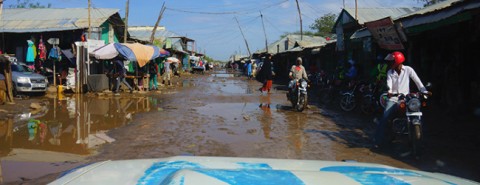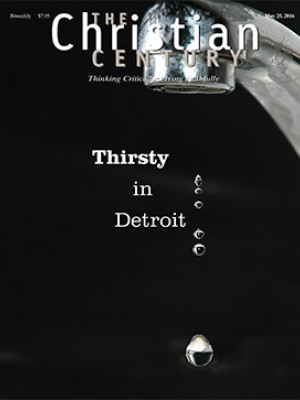Inside the refugee city: Anthropologist Rahul Oka on Kakuma, Kenya

Rahul Oka has been studying economic life at Kakuma Refugee Camp in northern Kenya, one of the largest refugee centers in the world. Opened in 1991, the camp contains over 179,000 people who have fled violence in Somalia, Sudan, Darfur, Ethiopia, and the Democratic Republic of the Congo. Oka is an anthropologist at the University of Notre Dame whose work focuses on urbanism and social networks. He is a consultant for the United Nations on how a camp like Kakuma could be turned into a viable city.
What most surprised you about the Kakuma camp?
I was surprised at how Kakuma is a thriving city and that its people live complex social and commercial lives.
For example, there is an Ethiopian woman who owns a shopping center in the middle of the city which is like a mini-Walmart. You can get everything there, from mattresses to cutlery and bridal gifts and birthday presents. She purchased the plot for $20,000 and is building a two-story shopping mall. She wants to add a gym and a furniture show room on the first floor, and an Internet café, Ethiopian coffee shop, and clothing boutique on the second. People in Kakuma make homes; they domesticate the landscape.
Read our latest issue or browse back issues.
So there is a thriving economy that goes well beyond the goods and services provided by relief agencies?
Aid that is given directly to refugees has a value attached to it, whether it is food or cash or vouchers. There are also hidden dimensions of this economy in which refugees will give the goods they receive directly to the hands of traders, who sit right outside distribution points. The refugees then take the cash and go directly to the commercial markets to buy the things they need.
The relief organizations sometimes try to control this trade, but there are elements within the relief organizations themselves that benefit from it. The informal or illicit economy also entails the sale of services, such as the sale of access by guards, who might demand a 1,000 shilling bribe to let someone enter the relief compound. Say a relief organization wants to hire a refugee as a cook. The refugee might say to the person doing the choosing, “I will give you $1,000 right now if you will hire me.” The person hiring then says, “OK. I will take $1,000 now and $500 from whatever the organization pays you.”
I won’t condemn the local people or refugees or relief workers who offer and accept these kinds of bribes. If people aren’t being paid adequately, then these become the perks of the job.
Selling the food donated by relief organizations is illegal, but it seems to be normal practice for refugees. What is going on?
It is easy to have a knee-jerk reaction against the sale of food. But imagine that you received a World Food Program package of dried maize and dried beans. You could boil the maize and eat it, but to do that you would need fuel to create a fire. If you are a refugee with absolutely no money, you can’t cook the maize unless you sell part of the food to buy wood. If you decide to grind the maize into powder, you need to pay the grinder. Somehow you have to sell a portion of your food in order to process the rest of it.
This reality creates a contradiction from the outset. The people in the WFP know this.
In your work with the UN, you talk a lot about refugees seeking normalcy and dignity. What do you mean?
There are a variety of ways to talk about these concepts in Swahili, Somali, and Pokomo, but each and every culture in that camp has them. One refugee told me, “If you come to my house and all I have to offer you is boiled water, I will feel that pinch for the rest of my life. If you come to my house and I greet you with tea with cloves and sugar and maybe a flax cake, I feel like a Somali man who has dignity.”
It seems refugee workers focus on ensuring safety and survival, while the refugees themselves think more broadly.
Maybe only 5 percent of refugees are ever resettled. Human life is always more than survival. People need to be able to celebrate birth, to celebrate life, to mourn and celebrate death—and they cannot do that with a UN package of food.
What kind of relationships are there between refugees and local people?
If you ask the local people in this region of Kenya, you might hear a little bit about what the UN isn’t doing. But then they will say, “If the UN was not here, we would all be dead.” The local people benefit from the camp because refugees employ local people as servants. The relief economy provides jobs and connections.
We compared a small town near Kakuma called Lorengo to a place where there has been a lot of economic development and to a third site where there used to be a refugee camp. We found that the health indicators of Lorengo were like those of the highly developed area. The place where the refugee camp is gone had reverted back to isolation and absolute poverty. The refugees provide access to food, support networks, cash for the local people.
It sounds like a great deal of adaptation goes on in the camp.
There is a great line in the book King Rat, by James Clavell, about a prisoner of war camp in World War II, which refers to the camp as a “place of genesis.” It was the place where human interactions and emotions are renegotiated and built up from scratch.
I am not trying to say that refugees come in as blank slates. But they have to decide what they are going to keep of the old and how they will adapt to the new.
One key aspect of this negotiation is generosity. Generosity is an aspect in the calculation of capital.
For example, one of the local communities in Kakuma has a practice called bond friendship. The friendship begins with “the ask.” Someone comes up to you and says, “Can you give me 100 shillings?” You have the option of saying yes or no or “How about I give you 20 shillings?” When you say yes, or when you negotiate, you create a bond of friendship, and it’s an enduring bond. That person might ask you every month for something, but they will also do small things for you. You become engaged in a personal economy.
One of the wealthiest men in Kakuma right now is an Ethiopian merchant. Every day an old woman comes to his shop, knocks her stick on his doorstep, and says, “This is my land. Pay me my rent.” He is wealthy enough to have her chased away without any repercussions, but instead he gives her 50 shillings and says, “Thank you, Mama, for letting me stay here.”
The local people call him “Baba,” and they protect him. He pays medical bills for the local people. He pays for education. He has permission to come to America, but he says, “Why would I want to go to America? Who will call me boss?”
Why is the UN interested in making Kakuma a self-sufficient city?
One of the reasons is donor fatigue. If the relief structure goes, we need something that provides alternatives.
But Kakuma is already a thriving city. Some parts of it should be left alone. And I don’t believe in top-down engineering. The parts that will succeed are the parts that are organic, and I am advising the UN on how to limit the engineering. A successful city is one that lets the revenue-generating sector thrive but then spends a lot of the revenue on creating a secondary, public-service sector: education, health, transportation, safety and security, infrastructure maintenance, and so on. Houses and basic necessities could be turned over to a Kakuma city council.
I also asked the UN if it was prepared to deal with the parts of a city that you don’t want—such as drugs, prostitution, and human trafficking. You cannot think that you will be able to shut them out. Is that something you can live with?
The print edition of this article incorrectly states the name of the town of Lorengo. This online edition was corrected on May 19, 2016. We regret the error.






